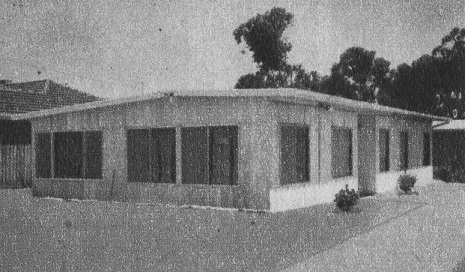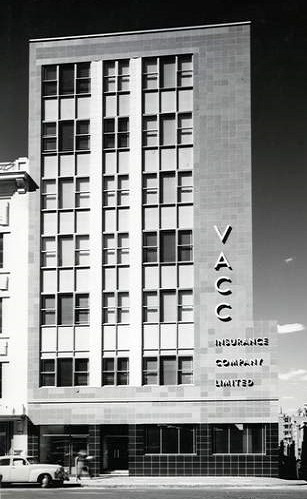The
post-war architectural practice of Gawler, Churcher & Blackett
represented a continuation of the successful pre-war practice of John
Stevens Gawler (1885-1978). A notable figure in the history of
architecture and town planning in Victoria, Gawler was born in England
but his family migrated to Australia when he was an infant. As a
teenager, he was articled to the offices of Gibbs & Finlay and, in
1903, won an RVIA Bronze Medal for a drawing. Leaving in 1907 to
oversee a construction project in China, Gawler remained overseas until
1912, travelling and working in the USA and elsewhere. Resuming
private practice in Melbourne in 1914, Gawler entered into partnership
with Walter Drummond (1890-1930) and gained a teaching position at
Melbourne University. During the inter-war period, the firm of
Gawler & Drummond was (as Miles Lewis put it) "prolific though
undistinguished", carrying out a range of residential, ecclesiastical,
commercial, institutional and industrial projects, including numerous
buildings for the university campus. During this time, Gawler also
maintained his own academic career, being appointed as a full-time
lecturer in 1920 and then Dean of the Faculty of Architecture in 1938,
while also retaining the right to private practice.
Notwithstanding Walter Drummond’s early death in 1930, the firm
continued to be known as Gawler & Drummond until 1941 when,
following the elevation to partnership of Tasmanian-born staff member
Eric Churcher (1892-1958), the practice was re-badged as Gawler &
Churcher.
As Miles Lewis has noted, Gawler himself was more influential as an educator, activist and reformer rather than as a design architect. A long-time resident of Nunawading, he was very active in local politics, serving as a council member of both the Shire of Nunawading and the City of Box Hill (1927-1951). His broader interests in housing and town planning saw him appointed as controller of building permits in the Department of War Organisation (1940), deputy chairman of the Commonwealth Housing Commission (1943) and founding chairman of the Town & Country Planning Board (1946). Holding these offices, Gawler retired from private practice in 1946, although his firm was continued by associates Eric Churcher and William Arthur Mordey Blackett (1873-1962). The latter, co-founder of the eminent and award-winning pre-war practice of Blackett & Forster, was a highly respected elder statesman of the Victorian architectural scene. By 1947, Blackett had been elevated to partnership in the firm known thereafter as Gawler, Churcher & Blackett.
In semi-retirement, Gawler served as president of the Municipal Association (1948-50) and as a part-time member of the Victorian Housing Commission (1949-53). By the mid-1950s, he had withdrawn from all of his positions and affiliations, save for membership of the Central Planning Authority. His architectural practice remained active, despite the deaths of long-time partners Eric Churcher and W A M Blackett in 1958 and 1962 respectively. Re-badged as Gawler, Churcher & Boardman, the office continued under Gawler’s son, David Phillip Gawler (1924-2013) and John Ellis Boardman, who became registered as an architect in 1962. The firm was finally dissolved in 1974, after sixty years, when David Gawler (who served as Mayor of Nunawading in 1971-72) and John Boardman decided to establish separate practices. Gawler senior died four years later, in 1978, aged 93 years. His family's long connection with the Nunawading and Box Hill areas continued, with son David undertaking several local projects, including the new Nunawading Arts Centre (1985).
As Miles Lewis has noted, Gawler himself was more influential as an educator, activist and reformer rather than as a design architect. A long-time resident of Nunawading, he was very active in local politics, serving as a council member of both the Shire of Nunawading and the City of Box Hill (1927-1951). His broader interests in housing and town planning saw him appointed as controller of building permits in the Department of War Organisation (1940), deputy chairman of the Commonwealth Housing Commission (1943) and founding chairman of the Town & Country Planning Board (1946). Holding these offices, Gawler retired from private practice in 1946, although his firm was continued by associates Eric Churcher and William Arthur Mordey Blackett (1873-1962). The latter, co-founder of the eminent and award-winning pre-war practice of Blackett & Forster, was a highly respected elder statesman of the Victorian architectural scene. By 1947, Blackett had been elevated to partnership in the firm known thereafter as Gawler, Churcher & Blackett.
In semi-retirement, Gawler served as president of the Municipal Association (1948-50) and as a part-time member of the Victorian Housing Commission (1949-53). By the mid-1950s, he had withdrawn from all of his positions and affiliations, save for membership of the Central Planning Authority. His architectural practice remained active, despite the deaths of long-time partners Eric Churcher and W A M Blackett in 1958 and 1962 respectively. Re-badged as Gawler, Churcher & Boardman, the office continued under Gawler’s son, David Phillip Gawler (1924-2013) and John Ellis Boardman, who became registered as an architect in 1962. The firm was finally dissolved in 1974, after sixty years, when David Gawler (who served as Mayor of Nunawading in 1971-72) and John Boardman decided to establish separate practices. Gawler senior died four years later, in 1978, aged 93 years. His family's long connection with the Nunawading and Box Hill areas continued, with son David undertaking several local projects, including the new Nunawading Arts Centre (1985).
Select List of Projects
Gawler & Churcher
| 1941 1945 | George Edwin Lambe Memorial Cottage, St Agnes’s Home for Girls, Glenroy Fitout for Tasmanian Government Tourist Bureau, 254 Collins Street, Melbourne |
Gawler, Churcher & Blackett
| 1947 1948 1954 1955 1956 | Residence, Bowen Street, Camberwell Residence, Illawarra Road, Hawthorn Residence, Bradley Avenue, Northcote Residence, Wonga Road, Ringwood Alterations and additions to Metallurgy School, University of Melbourne, Parkville Conversion of residence to junior school, Melbourne Girls' Grammar School, South Yarra Factory for Messrs Cerebos Australia Pty Ltd, Dandenong Road, Clayton Additions to factory, 202 Sydney Road, Brunswick Premises for Messrs Carter's Benalla Pty Ltd, Carrier Street, Benalla Additions to factory, corner Edward and Moller Streets, Oakleigh |
Gawler, Churcher & Drummond
| 1958 1959 1961 | Residence for John S Gawler, 116 Springvale Road, Nunawading [demolished] Renovation of office building for OTC, 382-386 Lonsdale Street, Melbourne Office building for VACC Insurance Co Ltd, 200 Queen Street, Melbourne Block of flats, Severn Street, Box Hill |
 | |
| John Gawler's own house in Nunawading (1958) |
 | |
| Office building for VACC Insurance, Queen Street (1959) |
 | |
| Flats in Severn Street, Box Hill (1961) |
 | |
| Flats in Severn Street, Box Hill (1961) (source: photograph by Built Heritage Pty Ltd) |
| Select References Miles Lewis, 'Gawler, John Stevens (1885–1978)', Australian Dictionary of Biography, Vol 14 (1996) |
top
